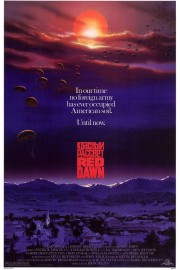Red Dawn
As someone who is a self-described liberal, watching John Milius’s “Red Dawn” again is an exercise in restraining laughter towards it’s paranoid, Cold War fear-mongering while also weeping at how it likely inspired the rise of the “Patriot militia” movement we see at work in groups like the one currently occupying a wildlife refuge in Oregon. (For the record- the timing of this choice to the Oregon militia occupation is entirely coincidental. I had the film slotted in this week last year.) As someone who grew up in the ’80s and watched many a movies in my childhood, however, I’d be lying if I don’t admit to still getting a charge at the entertaining thrills Milius delivers in this film. The combination of those two viewpoints makes “Red Dawn” more of a guilty pleasure than a genuinely enjoyable film, but that can be chalked up to how much I know about moviemaking, formulas and politics compared to what I did in 1984.
The film begins with text that sets the stage. The Soviet Union has become a powerful force, building alliances with countries in all corners of the Earth while NATO has lost it’s footing. The United States is now an isolated country. On a fall morning in the city of Calumet, Colorado, high schoolers are in class when they see parachutes drop outside. Maybe it’s a training exercise, although when their teacher is gunned down by the soldiers parachuting in, a nightmare begins for the citizens of this small town. A few of the students manage to get away, and hook up with Jed Eckert (Patrick Swayze), a former football star in the town, as they take to the hills to get away from the massacre and invasion happening in the town. In the hills, they start to fight back, calling themselves the “Wolverines,” against the Russian and Cuban invaders who have taken over the town, and brought forth the opening salvos of World War III. Can Jed, his brother Matt (Charlie Sheen), and their friends Robert (C. Thomas Howell), Daryl (Darren Dalton), Danny (Brad Savage) and “Aardvark” (Doug Toby), later to be joined by Erica (Lea Thompson) and Toni (Jennifer Grey), help save not just their town, but the American way of life?
Of course, World War III never took place during the Cold War, and while it is tempting to see the steps towards it again, it has not happened yet. “Red Dawn” takes place in an alternate universe, and requires plenty of belief in conspiracy theories and paranoia about the “commies” to get to the place the United States is in this film. However, if “Red Dawn” were simply conspiracy-minded paranoia and right-wing propaganda against the “reds,” it would be unwatchable 31 years later, and it is anything but. The screenplay by Milius and Kevin Reynolds (who would later direct “Robin Hood: Prince of Thieves,” “The Count of Monte Cristo” and “Waterworld”) may have conservative thinking at it’s heart, but it’s driven by a filmmaker’s appreciation for the genre it is based in. It understands archetypes and the necessity of strong story structure and character development to really tell a story, and that is where “Red Dawn” transcends it’s political soul and becomes something than anyone, regardless of political persuasion, can enjoy for the escapism it is. Milius (who also directed the original “Conan the Barbarian” and wrote “Apocalypse Now”) is working as a filmmaker and storyteller first and foremost, and the way he was shaped by the films of John Ford and B-movies plays a big part in the appeal of “Red Dawn,” and his approach to the material. Yes, it is ludicrous fear-mongering, but for many Americans at the time, it was not a fringe way of thinking, and Milius tapped into that masterfully by giving audiences a rousing story to get engaged in, with characters they could identify with, played by actors who were some of the brightest young stars of the decade. For Swayze, this remains a cornerstone to understanding the late actor’s appeal in that decade, with handsome looks that were more everyman than “sexiest man alive,” and a tough demeanor that could also be tender, as well; yes, his best-loved roles were as a romantic lead in “Dirty Dancing” and “Ghost,” but he’s very much at home leading a group of young soldiers in this film, as well. For Sheen and Howell, this was a piece of the puzzle of their careers that is very much a highlight in showing what they were capable of, while Gray and Thompson, despite best being known for classic, more traditionally “female” roles in “Dirty Dancing” and “Back to the Future,” respectively, show they are more than capable of kicking ass in this film. The idea of a youthful, rag tag militia fending off professional soldiers from a world superpower with limited resources is comedically absurd, but we go with it because the cast, and Milius, make us believe it could happen, and believe the resolve the Wolverines show, set to a thrilling score by Basil Poledouris. Kudos to John Milius for being able to marry his political views with his filmmaking talents, and make a film that doesn’t sacrifice an inch either way. Not a lot of filmmakers are capable of that balance. His film, which was the first film to get a PG-13 rating for it’s violence content, makes it look effortless.










